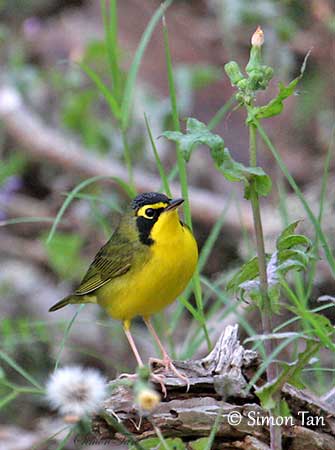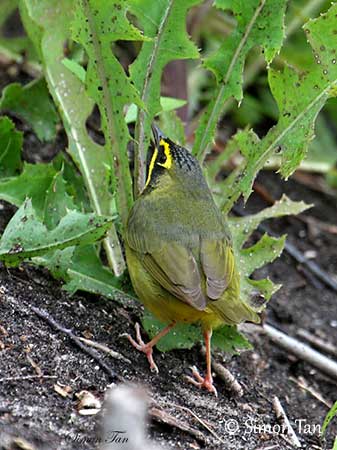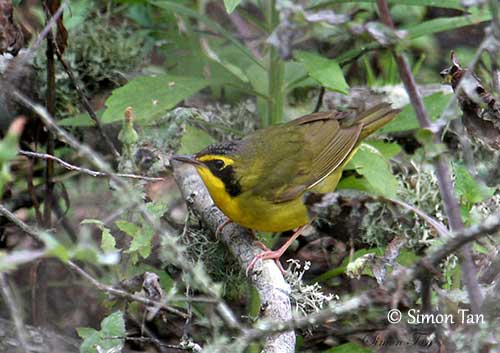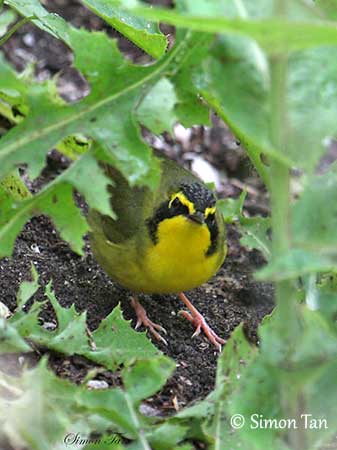
Fr: Paruline du Kentucky
Ang: Kentucky Warbler
All: Kentuckywaldsänger
Esp: Reinita de Kentucky
Ita: Parula del Kentucky
Nd: Kentuckyzanger
Sd: kentuckyskogssångare
Photographer:
Simon Tan
PBase Bird galleries
Text by Nicole Bouglouan
Sources:
HANDBOOK OF THE BIRDS OF THE WORLD Vol 15 by Josep del Hoyo-Andrew Elliot-David Christie - Lynx Edicions – ISBN: 9788496553682
A GUIDE TO THE BIRDS OF MEXICO AND NORTHERN CENTRAL AMERICA by Steve N. G. Howell, Sophie Webb - Oxford University Press - ISBN: 0198540124
FIELD GUIDE TO THE BIRDS OF NORTH AMERICA - National Geographic Society - ISBN: 0792274512
All About Birds (Cornell Lab of Ornithology)
The Birds of North America online
What Bird-The ultimate Bird Guide (Mitchell Waite)
Kentucky Warbler
Geothlypis formosa
Passeriformes Order – Parulidae Family
INTRODUCTION:
The Kentucky Warbler is unique in appearance and difficult to confuse with other warbler’s species in the family Parulidae. It feeds on insects and various other arthropods, and occasionally takes fruits. It is usually observed foraging on the ground and in low vegetation. This species is closely related to forest habitats, breeding in woodland with dense undergrowth and wintering in tropical forests.
After the breeding season, it migrates from E USA to Central America, and more irregularly in Caribbean Islands and N South America.
The Kentucky Warbler is generally common throughout its range, but some declines may occur due to degradation of the understorey by wild mammals, and deforestation in winter range.
But the species is not currently globally threatened.

DESCRIPTION OF THE BIRD:
Biometrics:
Length: 13 cm
Wingspan: 18-22 cm
Weight: 10-14 g
The Kentucky Warbler is a short-tailed and long-legged warbler.
The adult male has bright olive green upperparts, no wing bars and no tail spots or bars. The underparts are bright yellow, including chin and throat.
On the head, forehead, crown and head sides are black. The eyes are bordered by yellow stripe above, from lores to ear coverts, and below by thin incomplete yellow eye-ring. This yellow pattern forms “spectacles”. On the hindcrown, the feathers are tipped grey.
The thin, pointed bill is blackish with pale pink base to mandible. The eyes are dark brown. Long legs and feet are pale pinkish.
The female resembles male, but she is duller, with the black colour of the head sometimes reduced or mottled with greyish-olive.
The juvenile is similar to adults but duller, with rather olive-green than black areas. The adult head pattern is lacking.
RANGE:
The Kentucky Warbler breeds in Central and Eastern United States, as far as S Wisconsin to Pennsylvania.
It winters from E and S Mexico S to Panama, and the species is irregular in adjacent N Colombia and N Venezuela and Caribbean. They fly non-stop across the Gulf of Mexico.

HABITAT:
The Kentucky Warbler breeds in woodlands with luxuriant undergrowth near streams, usually at low elevation. It nests on or near the ground.
During migrations, the birds also frequent suburban gardens and parks.
They winter in undergrowth of moist tropical lowlands, and foothill second-growth forests, but also in mature tropical forests.
CALLS AND SONGS: SOUNDS BY XENO-CANTO
The Kentucky Warbler’s most common call is a low, sharp “chuck” or “chip”. The song is a series of rolling musical notes “churry churry churry”. Each note can be repeated six times. The second syllable is higher and shorter.
Only the male sings and it has usually one song type for all its life. Both adults and young give the common “chip”.
Both male and female may give high-pitched “teep” under extreme stress when predators threaten the nest. This call may be uttered as a single note or very rapidly, almost as a trill.
BEHAVIOUR IN THE WILD:
The Kentucky Warbler feeds on insects, caterpillars and small spiders during the breeding season. It may consume some fruits, according to the location.
It forages mainly on the ground by walking while searching for prey among the leaf litter. It probes and tosses leaves with its bill, and scratches the earth with its feet. It also searches for food in lower parts of trees. During the breeding season, it gleans and hawks insects from shrubs and trees. On the wintering grounds, they follow swarms of army ants. The wintering birds often defend a small foraging territory.
The Kentucky Warbler feeds alone, moving by walking and hopping on the ground, and with hops and short flights in low branches.

At the beginning of the breeding season, the male chases other males, but without, or rarely physical contact. These chases are interspersed with songs and aggressive “chip” notes at close range or while perched. The birds fly in circles or straight lines within territory boundaries. Male and female are territorial all year-round.
During pair formation, male and female chase or follow each other, hopping or making short distance flights through the low vegetation, while uttering loud and rapid “chip”. The female may sometimes give short songs. These displays attract other warblers of the same species and often, several birds are seen performing rapid circular chases while calling. The copulation occurs two days later, and the nest building starts the same day. They seem to be monogamous.
The Kentucky Warbler migrates by night, doing daytime stopovers with mixed species. The birds leave their breeding grounds in late July and August and arrive on the wintering grounds in late September after some stopovers.
They start the spring migration in early March and reach their breeding areas from early April, but mainly late April in N.
The Kentucky Warbler flies in straight lines. The flight is swift and direct, with rapid wing beats.

REPRODUCTION OF THIS SPECIES:
The breeding season occurs between May and August, with egg-laying in June-July.
Following the copulation, the female selects the nest-site. Both mates remain in visual contact during this period.
Most nests are on the ground, or are anchored partially in a small shrub. It is usually build between 3 centimetres and 1 metre above the ground and it is usually well hidden among the dense undergrowth.
The female builds the nest within a single day, with some help from the male. It is an open cup, made with woven coarse grasses. The base is often made with large oak leaves. The interior is lined with grasses and fine dark rootlets. The nest is placed between supporting stems or dead twigs in small brush pile.
The female lays 3 to 6 greyish white to creamy-white eggs often marked with brown or grey spots. The incubation lasts about 11 to 13 days, by female. The male remains within the territory, but rarely brings food to female.
The altricial chicks are naked with sparse down. They are fed by both parents but rarely by the male. They are fed on small insects and spiders. The young leave the nest about 8 to 9 days after hatching. They fly and follow their parents by 4 days after leaving the nest, and they remain in family groups for one month more if a second brood is not initiated.
If the nest is threatened by a predator, the female may perform some distraction displays, walking rapidly in zigzag fashion, dragging one or both wings and calling.
This species produces one brood per season, sometimes two.
The nests of this species are frequently parasitized by the Brown-headed Cowbird.
PROTECTION / THREATS / STATUS:
The Kentucky Warbler is vulnerable to forest destruction on tropical wintering grounds. Excessive disturbances at nest site may cause parents to abandon the nest. The White-tailed Deer (Odocoileus virginianus) destroys the understorey as the population of this species is increasing.
The population of this warbler is relatively stable and not globally threatened. The Kentucky Warbler is currently evaluated as Least Concern.